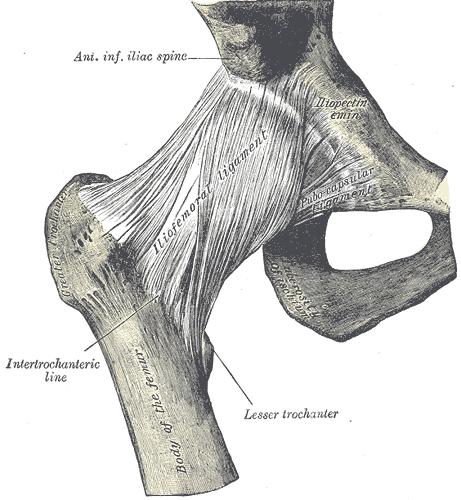Hip Quadrant Test
Definition/ description[edit | edit source]
The Hip Quadrant test is a passive test that is being applied to asses if there is any damage in structure in the inner and outer quadrant of the hip. The hip quadrant test is also known as the quadrant scour testCite error: Invalid <ref> tag; name cannot be a simple integer. Use a descriptive title. This test is not to be confused to the quadrant test for the lumbar spine.Cite error: Invalid <ref> tag; name cannot be a simple integer. Use a descriptive title
Clinically relevant anatomy[edit | edit source]
The most important structures of the art. coxae are the fossa acetabuli, facies lunata, labrum acetabuli, lig. transversum acetabuli, caput femoris, lig. ischiofemorale, lig iliofemorale and lig. pubofemorale. The art. Coxae is an articulation sphaeroidea.Cite error: Invalid <ref> tag; name cannot be a simple integer. Use a descriptive title [1]
Purpose
[edit | edit source]
The purpose of the Hip Quadrant test is to determine if there is a nonspecific hip pathology and a chance of ROM. This test does so by completing the ROM from flexion and adduction to flexion and abductionCite error: Invalid <ref> tag; name cannot be a simple integer. Use a descriptive title. This test is also capable to detect early hip degeneration.Cite error: Invalid <ref> tag; name cannot be a simple integer. Use a descriptive title
Technique[edit | edit source]
The patient lies supine on the table. The therapist stands on the side of the involved leg. He brings the hip and the knee to 90° flexion, the knee is directed towards the opposite shoulder (figure 1). One hand of the therapist is above the patient’s knee, the other is above the malleolis. Afterwards the therapist puts pressure on the leg by pushing the femur dorsally.Cite error: Invalid <ref> tag; name cannot be a simple integer. Use a descriptive titleCite error: Invalid <ref> tag; name cannot be a simple integer. Use a descriptive titleCite error: Invalid <ref> tag; name cannot be a simple integer. Use a descriptive title
In the first part of the exam the therapist adducts the patient's leg until the pelvis begins to raise off the table.
In the second part of the exam the therapist brings the leg of the patient in abduction with the hip still in 90° flexion and goes to abduction until the pelvis almost raises of the table. When he brings the leg to abduction it is important to keep the resistance on the leg and to go to from adduction to abduction in an arch.Cite error: Invalid <ref> tag; name cannot be a simple integer. Use a descriptive title
Result[edit | edit source]
The test is considered positive if the patient has any pain. The test is also positive if the therapist can feel any crepitus or if there is a leathery end feeling or if there’s a loss in ROM.Cite error: Invalid <ref> tag; name cannot be a simple integer. Use a descriptive title
The test is considered negative if you can go from flexion-adduction to flexion-abduction in an arch, a normal ROM and with a normal end-feeling.Cite error: Invalid <ref> tag; name cannot be a simple integer. Use a descriptive titleCite error: Invalid <ref> tag; name cannot be a simple integer. Use a descriptive title
Dysfunction[edit | edit source]
A positive Hip Quadrant test is an indication that there might be arthritis, an osteochrondral defect, avascular necrosis, joint capsule tightness and an acetabular labrum defectCite error: Invalid <ref> tag; name cannot be a simple integer. Use a descriptive title. This test also detects if the patients hip can move in the full range of motion.Cite error: Invalid <ref> tag; name cannot be a simple integer. Use a descriptive title
Recent Related Research (from Pubmed)[edit | edit source]
References
[edit | edit source]
- ↑ figure 1: http://www.healthbase.com/resources/images/







